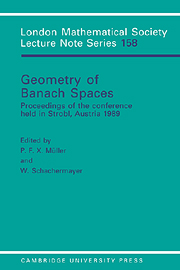Book contents
- Frontmatter
- Contents
- Foreword
- List of Main Lectures
- List of Participants
- A note on H. Ishihara and W. Takahashi modulus of convexity
- A property of non-strongly regular operators
- The entropy of convex bodies with ‘few’ extreme points
- Spaces of vector valued analytic functions and applications
- Notes on approximation properties in separable Banach spaces
- Moduli of complex convexity
- Grothendieck type inequalities and weak Hilbert spaces
- A weak topology characterization of l1 (m)
- Singular integral operators: a martingale approach
- Remarks about the interpolation of Radon-Nikodym operators
- Symmetric sequences in finite-dimensional normed spaces
- Some topologies on the space of analytic self-maps of the unit disk
- Minimal and strongly minimal Orlicz sequence spaces
- Type and cotype in Musielak-Orlicz spaces
- On the complex Grothendieck constant in the n-dimensional case
- Pathological properties and dichotomies for random quotients of finite-dimensional Banach spaces
- A note on a low M*-estimate
- The p1/p in Pisier's factorization theorem
- Almost differentiablity of convex functions in Banach spaces and determination of measures by their values on balls
- When E and E[E] are isomorphic
- A note on Gaussian measure of translates of balls
- Sublattices of M(X) isometric to M[0,1]
Remarks about the interpolation of Radon-Nikodym operators
Published online by Cambridge University Press: 03 May 2010
- Frontmatter
- Contents
- Foreword
- List of Main Lectures
- List of Participants
- A note on H. Ishihara and W. Takahashi modulus of convexity
- A property of non-strongly regular operators
- The entropy of convex bodies with ‘few’ extreme points
- Spaces of vector valued analytic functions and applications
- Notes on approximation properties in separable Banach spaces
- Moduli of complex convexity
- Grothendieck type inequalities and weak Hilbert spaces
- A weak topology characterization of l1 (m)
- Singular integral operators: a martingale approach
- Remarks about the interpolation of Radon-Nikodym operators
- Symmetric sequences in finite-dimensional normed spaces
- Some topologies on the space of analytic self-maps of the unit disk
- Minimal and strongly minimal Orlicz sequence spaces
- Type and cotype in Musielak-Orlicz spaces
- On the complex Grothendieck constant in the n-dimensional case
- Pathological properties and dichotomies for random quotients of finite-dimensional Banach spaces
- A note on a low M*-estimate
- The p1/p in Pisier's factorization theorem
- Almost differentiablity of convex functions in Banach spaces and determination of measures by their values on balls
- When E and E[E] are isomorphic
- A note on Gaussian measure of translates of balls
- Sublattices of M(X) isometric to M[0,1]
Summary
Introduction : A bounded linear operator T between Banach spaces X and Y is said to be a Radon-Nikodym operator if it maps bounded X-valued martingales into converging Y-valued martingales. In [G-J], an example is given of an R.N.P operator that does not factor through an R.N.P space (i.e a space where the identity is an R.N.P operator). However, the question is still open in the case of a strong R.N.P operator i.e. when the closure of the image of the unit ball by the operator is an R.N.P set in the range space.
This note consists of two parts. In the first, we shall prove that the interpolation method of [D-F-J-P] gives a positive answer to the above question if one considers what we call a controllable R.N.P operator (See the definition below). Most of the commonly known strong R.N.P operators are of this type. However, in the second part of this note, we shall give examples which are not. Actually, we shall construct strong R.N.P operators for which the [D-F-J-P] factorization scheme gives Banach spaces that contain C0. On the other hand, these operators are not counterexamples to the general problem because we do not know whether they factor through an R.N.P space by another scheme.
It is well known that the above mentioned type of questions is equivalent to the following interpolation problem:
Suppose C is a closed circled convex bounded R.N.P subset of a Banach space X.
- Type
- Chapter
- Information
- Geometry of Banach SpacesProceedings of the Conference Held in Strobl, Austria 1989, pp. 111 - 120Publisher: Cambridge University PressPrint publication year: 1991



